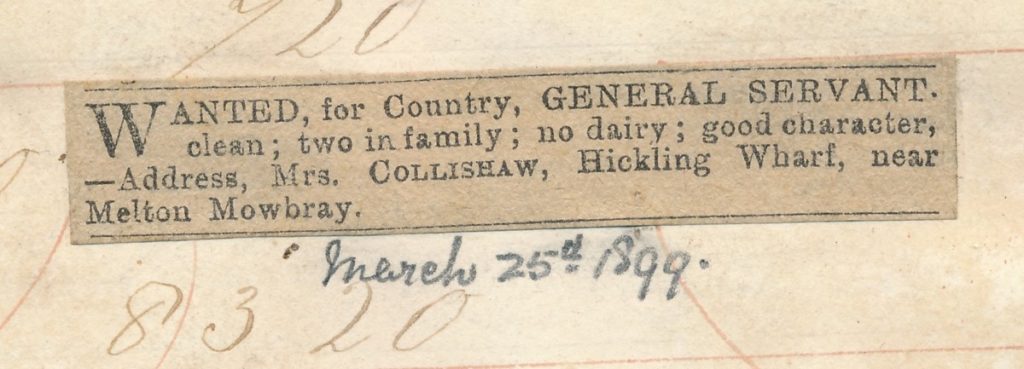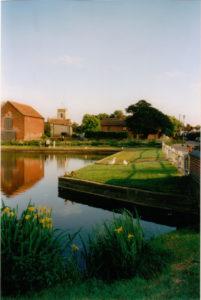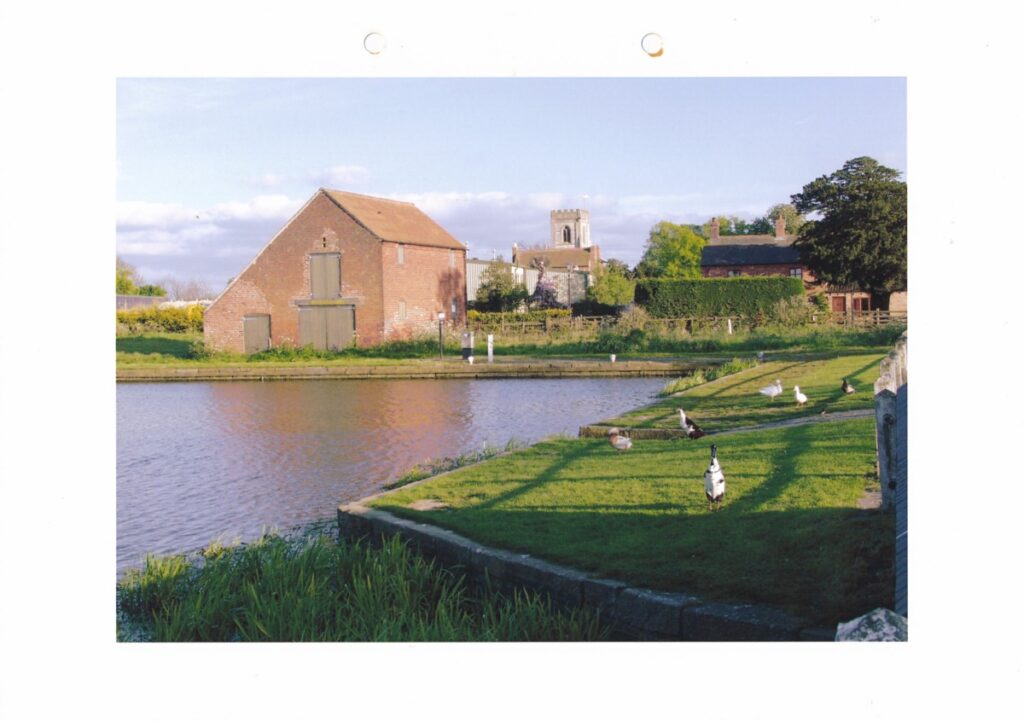
Hickling Basin & Wharf Building:
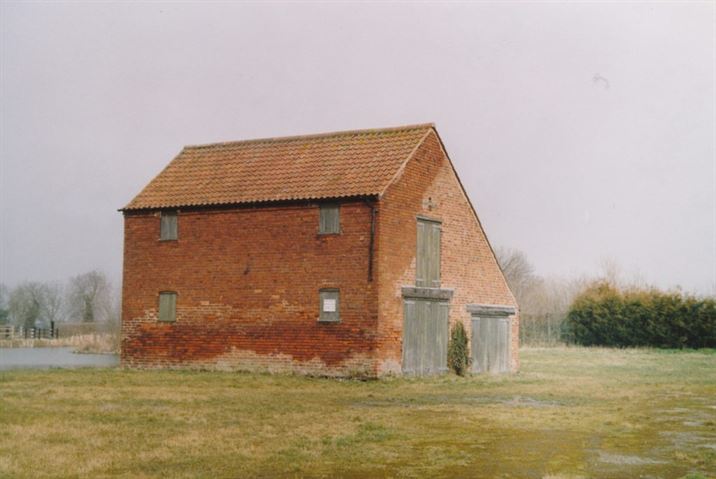
The surviving wharf and wharf building was one of two wharfs sited in Hickling; the second one was attached to the Navigation Inn (now Bridge House) to the west of the bridge in Hickling. Dating from the construction of the canal in the 1790s its original form, particularly its distinctive lop-sided sloping roof, is still very much in evidence.
Although the Grantham Canal is now a remainder waterway, the surviving wharf building has acquired real importance for the community over several generations (see Wadkin Archives, below). The Canal, the Basin and the Wharf Building are now formally protected as open spaces and listed buildings and, for the community, as our Village Green – spaces of real tranquillity in a busy world.
An article written in 1935 (Beauties of the Grantham Canal) looks back to the day-to-day routines around the canal; although the article isn’t entirely reliable, it records that (in its heyday) 20-30 boats might be moored at The Wharf next to The Navigation Inn (to the west of the road bridge) with horses stabled at The Navigation and the ‘navvies’ sleeping overnight at The Navigation and The Plough. The surviving Wharf building, sited next to the turning Basin to the east of the road bridge, was where the business was carried out – loading and unloading and providing a necessary turning circle for the Trent barges used to carry cargo.
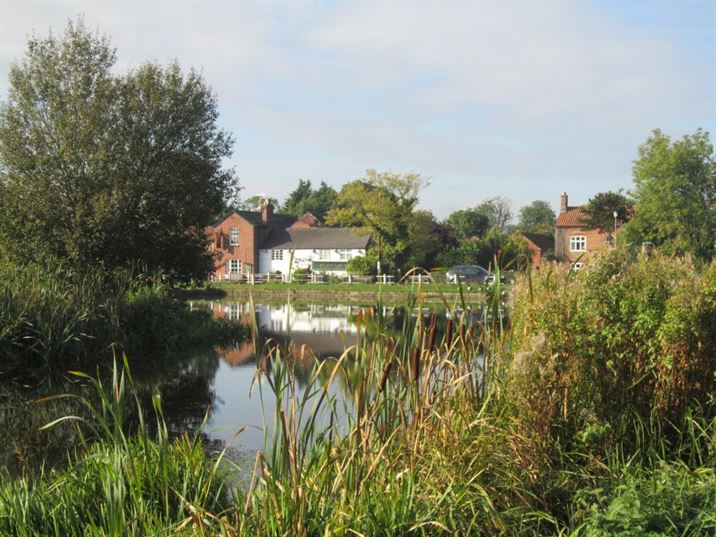
The Hickling Basin is the only Basin/turning point along the 33-mile length of the Grantham canal. It is also the legendary location for the whale which, children were told, swam the canal at night and turned in the only space which was large enough – Hickling Basin.
Unfortunately, we don’t have any photographs of the Wharf Building (or the whale!) during the working years of the canal; if you can help, please contact us.
Rainbow over Hickling Canal Basin (15/6/24)
The building is grade II listed: HICKLING MAIN STREET SK62NE (east side) 6/82 Canal Warehouse 25.9.79 Approx. 50 metres north north west of Wharf House GV II Canal warehouse. Late C18 or early C19. Brick, pantile roof. Rectangular on plan. 2 storeys. Two small windows to each floor, those on ground floor with segmental heads, those on 1st floor breaking into the dentil eaves cornice. All with stone sill. The roof sweeps over a continuous rear outshut whose rear wall has been rebuilt with blockwork. In each gable end is a large doorway above which is a smaller high-level doorway. The Grantham Canal was authorised in 1793. This section from the Trent to Leicestershire border was built by James Green, a surveyor employed by Lord Middleton of Wollaton Hall. The remainder was built by William King, agent to the Duke of Rutland at Belvoir. C Cove-Smith. The Grantham Canal Today, 1974. (Listing NGR: SK6912029438)

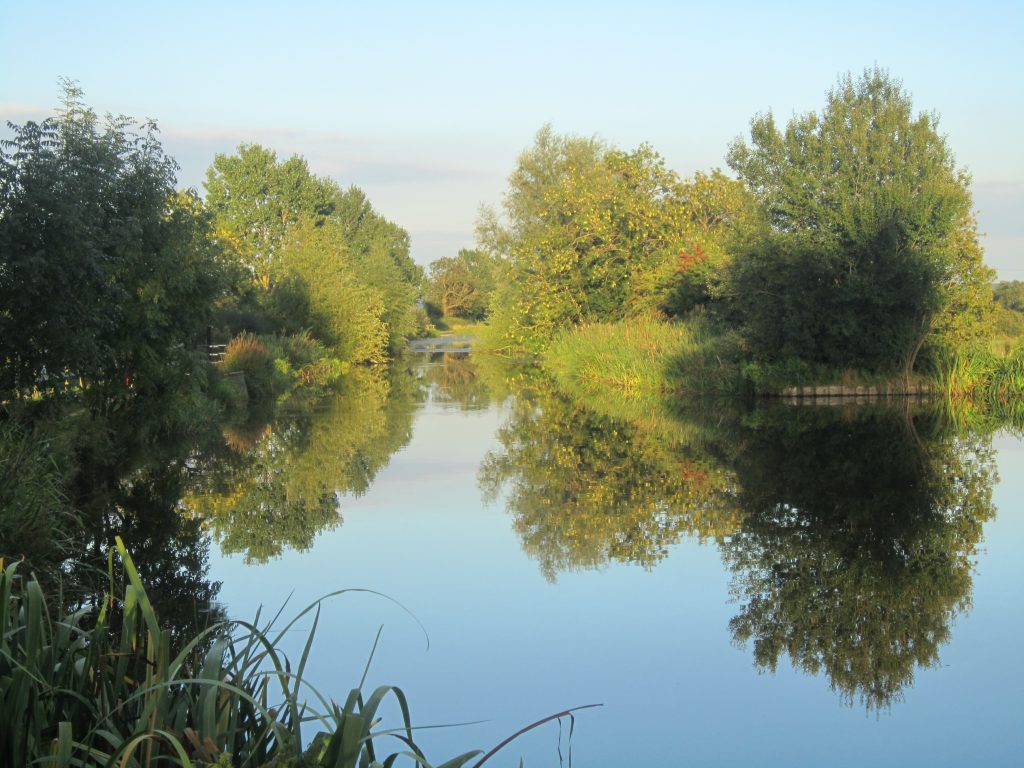
Canal Weighing Office/Building (Wharf)

(Wadkin Archive – labelling W0758 photograph from the canal bridge towards the Weigh Building) “Looking from the Canal Bridge: note the Navigation Inn sign on the right. On the left trees surround the Wharf House where Mr William Collishaw lived, also seen is the weighing office where Mr Collishaw sat and manipulated the weighing machine after vehicles had filled with coal, gravel, sand etc brought in barges on the canal and paid a fee on each load. The man seen on the left could be Mr Joseph Spencer, if so he lived at Bridge Farm, also conveyed corn, coal etc in his horse drawn barges on the canal via Nottingham and Grantham. Joseph Spencer died in March 1921 aged 77.”
At present, we don’t know exactly when it was built but it clearly links into the business interests of the Wharf Building. In July 1999 the Weighing Office was restored by the Faulks family; the windows were repaired, the chimney was rebuilt and the roof replaced.
Unlike other features of the Grantham Canal, the Weighing Office isn’t listed with English Heritage but it is a defining feature of this part of the village; latterly it has acquired an unofficial status as a village noticeboard.
Who were the ‘Wharf’ Collishaws?
The Collishaw family runs continuously through the history of Hickling for at least 400 years and probably longer; inevitably different branches of the family have come and gone at different times. In the 1800s and early 1900s there were at least 3 different Collishaw family groups and Christian names were often duplicated between these families; consequently, individuals acquired labels to help everyone distinguish between them – ‘the elder’, ‘the younger’, ‘of Waterlane’, of ‘Elm Farm’ –. One of these family groupings was formed by William and Betsy (Wharf) Collishaw – in 1885 there were 5 different William Collishaws living in Hickling and three Elizabeth Collishaws, although only Mrs (Wharf) Collishaw seems to have been known as Betsy.
William & Betsy lived in the Wharf House and William (Wharf) Collishaw was a coal merchant working from the Wharf and the weighing office that are still features of the location. The couple seemed to be well known for their community mindedness and their support for their neighbours; they gifted 5cwt of coal to widows and widowers each Christmas and following his retirement, William gave 5s instead. Both left legacies to the Church on their deaths. Both names also crop up regularly as witnesses in formal documents and Betsy Collishaw owned the cottage opposite the Wharf (now known as Old Mill Cottage) from at least 1885. However, Maggy Wadkin records her childhood memories of the couple less favourably! (see extracts, below)
William Collishaw was baptised in Hickling in 1849 and he married Betsy Dixon of Cotgrave in 1878; they don’t appear to have had any children. William was the nephew of the Waterlane Farm Collishaw family and his father, John, was also a coal merchant.
Census records don’t give precise addresses but by 1871 John Collishaw, coal merchant, is recorded (with his family) at The Wharf in Hickling. It isn’t clear how long the Collishaws managed the coal merchant’s business at the Wharf but John Collishaw was born in Wysall (father was a farmer) and he first appears in census records in Hickling in 1851 when he is described as a coal merchant. John’s wife, Sarah (Gill), was born in Hickling, they married in Nottingham in 1843 and their eldest child, Ann, is born in Hickling in 1845 which implies the family were settled in the village by then. Further research is needed; particularly into the possibility that the Gill family were linked to the Wharf/canal at the time of John and Sarah’s marriage.

(note; 1851 census – John Collishaw is listed as coal merchant and Henry Dickman as Wharfinger)
In the 1891 & the 1901 censuses, William (Wharf) Collishaw is recorded as a coal, coke and corn merchant. By 1911 he and Betsy are still at the Wharf but William is now retired. It is likely that the business closed at around this time as the canal traffic had been in decline for some time (although it is possible that it continued by road and/or on a different basis (research ongoing)).
Betsy Collishaw died in Hickling in March 1921 leaving an estate valued at £2,316.11s.3d. Property records show William Collishaw living in Owthorpe Cottage in Cropwell Bishop in 1922 and he died in Cropwell Bishop in September 1929 leaving an estate valued at £9,438.4s.3d.
- Chris Granger’s history records that Betsy Collishaw left a bequest to the Church in 1921 in her Will; it was used to install electricity to the building. Her husband, William Collishaw, also left a bequest to be used for general Church maintenance. The amounts bequeathed are unknown (further research needed).
- The Wharf property was sold by a conveyance dated 28th July 1921 to JW Harriman ‘in fee simple’ with access to the water pump retained as a right for tenants of Old Mill Cottage.
- Old Mill Cottage – conveyance dated 25th February 1930; the sale is made by Charles William Collishaw on behalf of the late William (Wharf) Collishaw. The representatives of William Collishaw (deceased) sell the house to Mr Herbert Swanwick; the sum paid is £155 ‘in fee simple’ and without incumbrances; Mr Swanwick retains the right to access water from the pump at The Wharf (still owned by Mr JW Harriman).
- Frequent mentions of James Wright Collishaw (Waterlane Farm) alongside William & Betsy (Wharf) Collishaw indicate close links between the two parts of the family.
Harriman:
- The Wharf property was sold by a conveyance dated 28th July 1921 to JW Harriman ‘in fee simple’ with access to the water pump retained as a right for tenants of Old Mill Cottage.
- John Harriman was the son of Mr Harriman the baker whose shop and post office was in the house now known as Cobblestones. The Wadkin archives record that John Harriman moved to the Wharf House on his marriage to Amelia Stubbs.
- In 1932 there is a record of Mr JS Featherstone (on behalf of the Notts Education Committee) giving a demonstration of hedge-laying ‘at the farm of Mr JW Harriman, the Wharf, Hickling’. This seems to indicate a move away from canal-based business and into farming.
- A further conveyance of Old Mill Cottage in 1963 notes that the new occupiers also have the right to extract water from the pump at the Wharf (still owned by Mr JW Harriman).
Timeline:
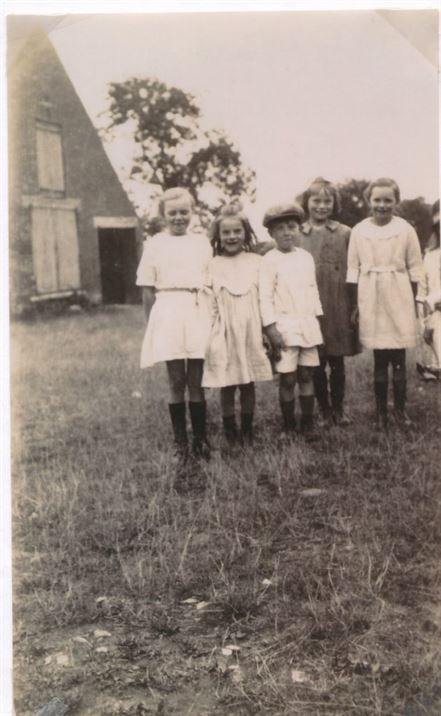
- 1774 Enclosure Act: work is ongoing to identify who owned the land which was then sold/ceded to the construction of the Canal. The Revd Robert Barker, John Collishaw, Thomas Burrows and Robert Barker are named in the canal land transactions at the time. The Enclosure Act shows land to the west of Main Street is owned by James Burrows (making Thomas Burrows an unlikely owner) and land to the east of the Wharf location is owned by the Revd Robert Barker and John Collishaw; it is possible one or both of them also owned the neighbouring parcels of land up to Main Street (transcription of the Enclosure Act schedule is ongoing).
- 1792-7: The turning basin in Hickling is clearly marked on the original plans published in 1792 but the Wharf Building isn’t shown. Private businesses such as the Navigation Inn would have grown naturally with the construction of the canal to satisfy the needs of canal users; at present, it isn’t clear whether the Wharf business has similar origins and was always privately owned/managed but it is likely.
- Early 1800s: It isn’t known who managed the Wharf business in the early years (please contact us if you can help with this).
- 1843-1921 (?): Census records don’t give precise addresses but by 1871 John Collishaw, coal merchant (not the John Collishaw named in land transactions, above), is recorded (with his family) at The Wharf in Hickling.
- It isn’t clear how long the Collishaws managed the coal merchant’s business at the Wharf but John Collishaw was born in Wysall (father was a farmer) and he first appears in census records in Hickling in 1851 when he is described as a coal merchant.
- John’s wife, Sarah (Gill), was born in Hickling, they married in Nottingham in 1843 and their eldest child, Ann, is born in Hickling in 1845 which implies the family were settled in the village by then. Further research is needed; particularly into the possibility that the Gill family were linked to the Wharf/canal at the time of John and Sarah’s marriage.
- (note; 1851 census – John Collishaw is listed as coal merchant and Henry Dickman as Wharfinger)
- In the 1891 & the 1901 censuses, William (Wharf) Collishaw is recorded as a coal, coke and corn merchant. By 1911 he and Betsy are still at the Wharf but William is now retired. It is likely that the business closed at around this time as the canal traffic had been in decline for some time (although it is possible that it continued by road and/or on a different basis (research ongoing)).
- see section above; ‘Who were the (Wharf) Collishaws?’
- 1911: William (Wharf) Collishaw is recorded as retired and it is likely the Wharf business has closed by this time. He continues living here following Betsy’s death in 1912.
- Property records show William Collishaw living in Owthorpe Cottage in Cropwell Bishop in 1922 and he died in Cropwell Bishop in September 1929
- By 1924: a photograph of children from the Squires and Wiles family taken in the yard of the Wharf Building in 1924 shows that the area has already grassed over by this time and the building is showing signs of deteriorating.
- 1921-1941 (?): The Wharf property was sold by a conveyance dated 28th July 1921 to JW Harriman ‘in fee simple’ with access to the water pump retained as a right for tenants of Old Mill Cottage.
- Old Mill Cottage – conveyance dated 25th February 1930; the sale is made by Charles William Collishaw on behalf of the late William (Wharf) Collishaw. The representatives of William Collishaw (deceased) sell the house to Mr Herbert Swanwick; the sum paid is £155 ‘in fee simple’ and without incumbrances; Mr Swanwick retains the right to access water from the pump at The Wharf (still owned by Mr JW Harriman).
- John Harriman was the son of Mr Harriman the baker whose shop and post office was in the house now known as Cobblestones. The Wadkin archives record that John Harriman moved to the Wharf House on his marriage to Amelia Stubbs.
- In 1932 there is a record of Mr JS Featherstone (on behalf of the Notts Education Committee) giving a demonstration of hedge-laying ‘at the farm of Mr JW Harriman, the Wharf, Hickling’. This seems to indicate a move away from canal-based business and into farming.
- A further conveyance of Old Mill Cottage in 1963 notes that the new occupiers also have the right to extract water from the pump at the Wharf; this document states that the Wharf is still owned by Mr JW Harriman, however, other records indicate a sale in 1941.
- 1941: the Wharf House and Wharf Building passed to Mr Douglas Booth of Harby (perhaps sold by Mr Harriman; John William Harriman died in Harby in 1958). In the 1950s the east wall fell down and was rebuilt in block work. In 1995, following the English Heritage listing of the building, the owners were required to undergo restoration work to make the building water tight – English Heritage gave a grant of £3,232 to cover 25% of the cost. In 2014 the building was re-pointed with lime mortar. The traditional curtilage was split up in 1963 when the Wharf House and the rest of the site was sold to the Faulks family whilst the wharf building itself remained in the ownership of the Booth family.
- 1994-2000: Restoration work carried out along the canal and around the basin by the Grantham Canal Restoration Society.
- 2015-present: the lease of the Old Wharf Building was sold and planning permission given to open The Old Wharf Tearooms – “Change of use to cafe/tea rooms and bike hire/repairs, and construction of new toilet block. The Old Wharf Building Main Street Hickling Nottinghamshire.”
The Canal, Basin & Plough Inn – photographs 1999-2005
We have been given these beautiful photographs which range in date between about 1999 and 2005; unfortunately, we don’t know the name of the photographer – if you can help, please contact us.
They include images of the Canal, the Basin, the Wharf Building, the Plough Inn, the Lengthsman’s Hut and the Smite Aqueduct.































From the Wadkin Archives:
(Wadkin Archive – labelling W0758 photograph from the canal bridge towards the Weigh Building): “Looking from the Canal Bridge: note the Navigation Inn sign on the right. On the left trees surround the Wharf House where Mr William Collishaw lived, also seen is the weighing office where Mr Collishaw sat and manipulated the weighing machine after vehicles had filled with coal, gravel, sand etc brought in barges on the canal and paid a fee on each load. The man seen on the left could be Mr Joseph Spencer, if so he lived at Bridge Farm, also conveyed corn, coal etc in his horse drawn barges on the canal via Nottingham and Grantham. Joseph Spencer died in March 1921 aged 77.”
Scrapbook of Hickling:
- Page 22: (extracts) occupations listed by census year – 1851, 1861, 1871
- Occupation 1851 1861 1871
- Boatman 9 12 2
- Boatowner/cottager 1
- Canal Labourer 1
- Carrier 2 4 1
- Carter 11
- Coal Merchant 1 1
- Publican/Innkeeper 1 2 2
- Lime Merchant 1
- Warehousewoman 1
- Wharfinger 1
- Wharfinger & Coal Merchant 1
- (note; 1851 census – John Collishaw is listed as coal merchant and Henry Dickman as Wharfinger)
- Page 45: Coal Merchants. Coal was brought along the canal on barges and tipped into the Wharf Yard then re- loaded on to horse drawn carts. Following this, coal came by rail trucks and tipped at Old Dalby Station or occasionally Widmerpool, then collected by horse and cart. Delivery often took several days. Coal merchant was Mr. Harry Brooks from Hose and Mr. Malcolm King of Long Clawson who delivered on a specific day of the week. Today three coal merchants deliver in the village:- Mr. John Grice from Hickling Pastures, Mr. Ernest Tinsley, Long Clawson (one time assistant to Mr. M. King) and Mr. Henry Coy from Harby who bought Mr. H. Brooks’s business. In 1885 Mr. Bill Collishaw was a coal merchant and warfinger.
Maggie’s Memories:
- Page 55: Travelling Fair. The first I recall set up their roundabouts in the paddock where now stands ‘The White House’ opposite the Rectory Gate, then transferred to either the Wharf Yard or the Plough Inn Paddock, besides round-a-bouts there would be shooting at clay pipes, coconut shies and skittles. I can’t remember how much we paid. We kids loved the ‘Fair’, but many of us had strict orders not to stay long because it was near the public house.
- Page 56: I remember our Postman riding a red cycle from Upper Broughton railway station to Hicking (the postman travelling by train from Melton to Broughton) he had his own ‘Postman’s Hut’ near the Canal, where he could take a nap, make a cup of tea, and often he would go fishing in the Basin, when the time came to collect mail from the letter boxes he would cycle back and catch the Melton train at Broughton. (it is possible that this was the Weighing Office on the Wharf – research ongoing.)
- Page 59: Coal and Merchants Coal was brought in Barges on the Canal at one time and tipped on to the Wharf Yard, and then re-loaded on to horse and cart. After the barges, came railway trucks of coal. Often a truck of coal was shared by two families; the coal would arrive at Old Dalby Railway Station and sometimes Widmerpool, and then the horses with heavy carts would be backwards and forwards sometimes several days, especially if there were two trucks to be emptied, I can remember loads of coal being tipped on to the road and then being taken to the coal house by wheelbarrow. Granny Simpson’s coal merchant as I remember was Mr. Harry Brooks then Mr. Malcolm King of Long Clawson came to Hickling and other villages, first with horse and dray then a coal lorry, in those days the Coalman always delivered on a specific day each week, now one must order fuel either by phone or post and it will be delivered. There have been a number of different coal merchants with customers here over the years, another custom completely changed. When I first married I remember giving as little as 1/6d, one shilling and sixpence for cwt. of coal, now it is £2 or more anthracite dearer.
- Page 61: Wharf Yards. I remember how we children stood on the canal bridge to watch the horse drawn barges on the water unload their cargo on to the wharf yards, there was two yards, one on the Canal Basin side where the Red Brick Barn still stands (rather delapidated) and the other by the side of the Navigation Inn (which is now a private house called Bridge View). The barges unloaded coal, sand, gravels, etc. and it was seldom the wharf yards were empty. Several times the barge men have given we children rides on the barge, and we loved it.
- Page 83: Mr. William Collishaw Lived at the ‘Wharf’ with his wife, there were three families of Collishaws in Hickling but were not related to one another. This family were always called Mr. & Mrs. Wharf Collishaw, they had no family, Mr. Collishaw was Church Warden as long as I remember until he moved to Cropwell Bishop on the death of his wife, he had white hair, always wore a bowler hat and dressed in black, mostly a frock coat, they each were typical Victorians, very strict, serious, and children were afraid of them, Mrs. Collishaw also mostly wore black and a very large hat and she was a tiny person, she kept a maid who wore a black dress and white cap and apron, but they never stayed long, Mrs. C. was a tyrant to her housemaids. Mr. Collishaw had a brick office in the wharf yard, with fireplace, cupboards, desk and chair, a window with wooden shutter, and outside a large weighing machine on the ground where horse & cart would be driven to be weighed before and after loading with either coal, sand, gravel etc. from the wharf yard, Mr. Collishaw would manipulate the machine and hand out tickets through the open cubby hole window, we kids would think ourselves clever and stand on the weighing machine expecting to be weighed (we never let Mr. Collishaw see us if we could help it.) Mr. Collishaw also issued fishing tickets for use of anglers on his land, he would walk around each day collecting his sixpences. There were two large iron gates at the entrance to the Wharf Yard which were locked each night and all day on Sunday. Part of the house has now been demolished.
- Page 87: (…) Poor old Shot caught a chill which turned to pneumonia, he was in the Wharf barn on the main street, the police were informed and he was taken by ambulance to Bingham Workhouse where he died. The local British Legion gave him a respectful funeral and he was buried in Kinoulton Churchyard.


Wharf Building – including interiors & large nest (June 2008):





